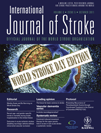N-terminal probrain natriuretic peptide as a biomarker of cardioembolic stroke
Conflict of interest: None declared.
Abstract
Background and purpose N-terminal probrain natriuretic peptide, which is mainly produced by the heart, is increased in acute stroke. We aimed to determine if N-terminal probrain natriuretic peptide could be a biomarker for ischemic stroke with a cardioembolic cause.
Methods Consecutive sample of acute stroke patients admitted to a Stroke Unit. Ischemic stroke subtype was classified using the TOAST classification. Blood samples were drawn within 72 h after stroke onset. Serum N-terminal probrain natriuretic peptide concentration was measured using an electrochemiluminescence immunoassay. Mean values of N-terminal probrain natriuretic peptide were compared between patients with hemorrhagic stroke vs. ischemic stroke, cardioembolic stroke vs. noncardioembolic stroke, cardioembolic stroke with atrial fibrillation vs. noncardioembolic stroke using t-test. Receiver operating characteristic curves were used to test the ability of N-terminal probrain natriuretic peptide values to identify cardioembolic stroke and cardioembolic stroke with atrial fibrillation.
Results Ninety-two patients were included (66 with ischemic stroke) with a mean age of 58·6 years. Twenty-eight (42·4%) ischemic strokes had a cardioembolic cause. Mean N-terminal probrain natriuretic peptide values for cardioembolic stroke were significantly higher (P<0·001) (491·6; 95% confidence interval 283·7–852·0 pg/ml) than for noncardioembolic ischemic stroke (124·7; 86·3–180·2 pg/ml). The area under the receiver operating characteristic curve for N-terminal probrain natriuretic peptide in cardioembolic stroke was 0·77. The cut-off point with the highest sensitivity and specificity was set at 265·5 pg/ml (71·4% and 73·7% respectively). The area under the curve of N-terminal probrain natriuretic peptide for cardioembolic stroke related to atrial fibrillation was 0·92, cut-off was set at 265·5 pg/ml (sensitivity 94·4%, specificity 72·9%).
Conclusion N-terminal probrain natriuretic peptide is a biomarker with a good accuracy to predict ischemic stroke of cardioembolic cause, namely associated with atrial fibrillation.




